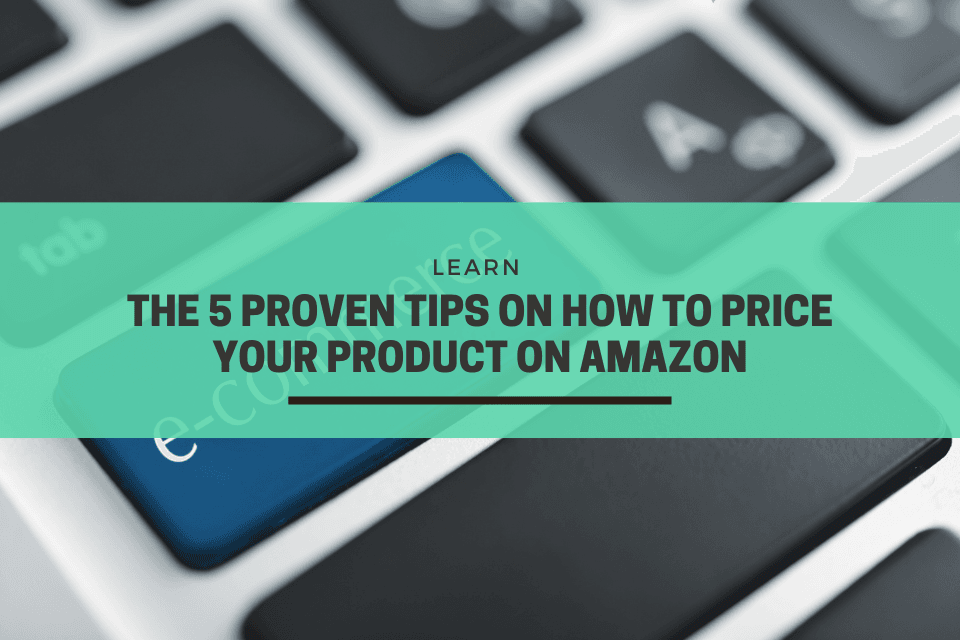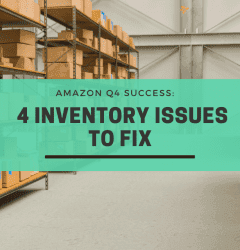This website uses cookies so that we can provide you with the best user experience possible. Cookie information is stored in your browser and performs functions such as recognising you when you return to our website and helping our team to understand which sections of the website you find most interesting and useful.
06 Sep

Learn the 5 Proven Tips on How to Price Your Product on Amazon
As a seller, product pricing is one of the most crucial decisions that can help your business prosper on a competitive marketplace like Amazon. However, more often than not, sellers consider pricing to be more of a set-it-and-forget-it activity, rather than an ongoing strategy that needs to be tested and evolved over time.
82% of buyers in the US state that pricing is the most important factor driving their purchase decision on Amazon. From a selling point of view as well, pricing plays a big role in determining how you rank on the Search Page and also, your chances of winning the Buy-Box. Hence, we understand how determining the right price for your product can seem to be a daunting task!
In this blog, we will introduce you to various factors to be kept in mind while deciding on how to price your product. We will also talk about different kinds of pricing strategies depending on your business needs and goals. While these factors are not exhaustive, they will help you move in the right direction.
Calculating Your Optimal Price Range
In order to arrive at a final price for your product, the first step is to count all your costs along the way. There are primarily two kinds of costs associated with selling on Amazon:
- Product Costs: These include the cost of manufacturing/sourcing the product, transportation, handling charges, storage costs, etc.
- Selling Costs on Amazon: There are certain cost components & fees that Amazon charges you as a seller. These include shipping, packaging and handling charges depending on the shipping method, referral fee as per your product category, variable closing fee, and some other expenses based on your selling plan. To get an initial estimate of the various charges for a product, you can use the shipping fee calculator for Amazon.com. Similar tools are also available for other Amazon marketplaces.
Over and above this, there will also be other cost components such as advertising spends on and off-Amazon, cost of promotions like deals and coupons, and other marketing expenses to garner higher sales for your product. Taking all these costs into account and considering the net margin for your SKUs will help you determine a comfortable price point.
Identify the Right Audience
To further finetune your pricing strategy, it is crucial to understand the audience for your product and their purchase behaviours. For example, a beauty product on Amazon serving the same purpose could be priced for $5 or even for $50. But, both these products will be catering to different sets of audiences. The factors determining the price range preferred by different demographic groups could be their disposable incomes, the amount they are willing to spend for the same product, their frequency of purchase and much more.
To arrive at the right price for your product, create a customer persona template of your target audience. The template should describe your ideal customer to the tiniest detail – their age group, demographic, gender, annual income, interests & dislikes. If you are already selling on Amazon, you can use Amazon Brand Analytics to get detailed insights into your customers’ search and purchase behaviours, and their demographics. You can then craft a pricing strategy to appeal to your highest value customers.
Price Elasticity and Industry Trends
Different products behave differently in the market, especially when there are price changes involved. For instance, a sudden drop in a product’s price might increase its demand significantly, while for some others it might not cause any difference in the way it sells. This price elasticity depends on various factors such as whether the product is a mass-market product, a specialty product or a luxury product; whether it has year-round demand or seasonal usage; whether it has too many substitutes available, etc. Understanding price elasticity helps in optimizing your pricing strategy on Amazon. It is also crucial to keep a close track on the industry trends, and the pricing patterns in your product category.
Competition Pricing
Considering how competitive Amazon is as an eCommerce platform, it is crucial to analyze your competitors’ pricing strategy to get ahead of them. Keep a check on what the prices of similar competitor products are, how often do they offer discounts, how much do they generally extend as reduction on selling price, when do they run lightning deals, what is their maximum discounted offer on deals of the day, etc. A good idea is to also monitor the price change history of your competitors and understand if these price changes also lead to a change in the best seller ranks on their products. All of these will help you in identifying patterns in your competitors’ pricing, and ultimately, in crafting your own strategy.
Different Pricing Strategies
Perhaps the most important part of pricing a product on Amazon would be the actual pricing model adopted, depending on the needs and goals of your business. In our experience of working across thousands of products on Amazon, following are some of the most widely used models:
Competitive Pricing with Low Margins: This strategy is used when the customer’s buying decision majorly depends on the products’ price and when there is no product differentiation. This is particularly true if your product is a mass-market product or a product that fulfils everyday needs, with many competitors targeting the same audience.
- Premium Pricing with High Margins: The idea with this strategy is to price the product higher than competitors to encourage a favorable perception among buyers. For premium pricing, ensure that your product has a unique feature that competitors cannot offer and that these features are highlighted in your listing. These need not be product specific; they could also be propositions like your intrinsic brand value, some special packaging, or any kind of feature that increases your credibility, such as an organic certification.
- Dynamic Pricing: This is used when you want to adjust prices rapidly as per market conditions, or if you wish to be a price leader in your category. You can basically charge consumers different prices at given points in time, for the same product. This may depend on: the traffic on the Amazon marketplace, consumer demand, the pricing of your competitors, the seasonality trends in your product’s usage, etc. However, use this with caution as constantly changing prices may detract from your brand, or drive you into price wars with competitors.
- Launch at High Price and Lower to Stable Pricing: This is an adaptable pricing strategy, where the seller usually starts off with a higher pricing during the initial launch and slowly reduces it to arrive at a more stable pricing. This is generally done if you have a highly anticipated product, or if you are a product pioneer, or if limited numbers are available initially.
- Loss Leader Pricing Strategy: Loss leader pricing often prices the product much lower than the competition, such that the seller often incurs a loss over the sale. This is mostly done by sellers who want to introduce a new brand in a segment or appeal to a large audience. Another way this strategy can be utilized on Amazon is for products where you are offering various color or size variations. For example: the top-performing variation can be priced at much lower prices to attract higher traffic, while other variations can be priced higher to make up profits.
- However, you may risk your product being labeled as a cheap product when using this strategy.
- Deals and Strikethrough Pricing: Strikethrough pricing is useful to attract the attention of the customers on Amazon. It gives the idea to the customer that they are receiving a pricing bargain, above and beyond the already competitive price. This helps in winning over the customer, but will most certainly be imitated by competitors in the same segment.
- Absolute Value Pricing: This is a common pricing strategy wherein complementary products are bundled together to increase the total value of a customer purchase. You can also offer discounts on multi-packs to provide more value to the customer. This seems like a win-win situation for both. The customer gets the product at a price lower than the sum of the individual product prices, and the seller can maximize the basket size of the buyer at a lower Amazon fulfilment fee. Sellers can use this strategy to introduce new products, increase the sales of slow moving goods, or position the offering as a gifting item.
Testing the Selected Pricing Model
Even after following all the above steps carefully, it is possible to arrive at a not-so-optimum pricing strategy for your business. To beat this, it is imperative to listen to the voice of the customer regarding price. Primarily, you must keep an eye out on the product reviews, study negative reviews, where the product is failing to impress, and if customers are talking about the price. Another way would be to conduct A/B testing on the prices and determine what prices prompt the customer to make a purchase. It is also crucial to constantly monitor any pricing changes & promotions on your competitors’ listings, to take quick action where necessary.
All in all, there are a host of factors that determine the success of your products on Amazon, and pricing definitely lands at one of the top spots in this list. There are no cutting corners when it comes to strategizing and implementing the right pricing model for your products. Make sure to consider the various tips and strategies mentioned above, and find the one that suits your products, brand, and general business.
Related Post
Industries Served
United States
India













